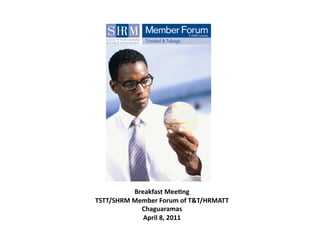Chaguaramas breakfast meeting
- 1. Breakfast ┬ĀMee+ng ┬Ā TSTT/SHRM ┬ĀMember ┬ĀForum ┬Āof ┬ĀT&T/HRMATT ┬Ā Chaguaramas ┬Ā April ┬Ā8, ┬Ā2011 ┬Ā
- 2. SHRM ┬ĀMember ┬ĀForum ┬Āof ┬Ā ┬Ā Trinidad ┬Ā& ┬ĀTobago ┬Ā
- 3. De’¼üning ┬Āthe ┬Ādi’¼Ćerences ┬Ā ┬Ā between ┬ĀHR ┬Āen==es ┬Ā ŌĆóŌĆ» HRMATT ┬Ā ┬Ā ŌĆóŌĆ» SHRM ┬Ā ŌĆóŌĆ» SHRM ┬ĀMember ┬ĀForum ┬Āof ┬ĀTrinidad ┬Ā& ┬ĀTobago ┬Ā ŌĆóŌĆ» HRCI ┬Ā
- 4. Why ┬Āget ┬Ācer=’¼üed ┬Āin ┬Ā ┬Ā Human ┬ĀResources? ┬Ā ŌĆóŌĆ»Show ┬Āyou ┬Āknow ┬Āthe ┬Āmost ┬Ā current ┬Āprinciples ┬Āand ┬Ācore ┬Ā prac=ces ┬Āof ┬ĀHR ┬Āmanagement ┬Ā ŌĆóŌĆ»Become ┬Āmore ┬Āmarketable ┬Ā when ┬Āyou ┬Ācompete ┬Āfor ┬Ātop ┬Ā HR ┬Āposi=ons ┬Ā ŌĆóŌĆ»Raise ┬Āyour ┬Āprofessional ┬Ā con’¼üdence ┬Āamong ┬Āyour ┬Āsta’¼Ć ┬Ā and ┬Āyour ┬Āpeers ┬Ā ┬Ā
- 5. PHR/SPHR ┬ĀEligibility ┬Ā PHR ┬ĀEligibility ┬Ā ┬Ā ŌĆóŌĆ» 1 ┬Āyear ┬Āof ┬Ādemonstrated ┬Āprofessional ┬ĀHR ┬Āexperience ┬Āwith ┬Āa ┬ĀMasterŌĆÖs ┬Ā degree ┬Āor ┬Āhigher ┬Ā ┬Ā ŌĆóŌĆ» 2 ┬Āyears ┬Āof ┬Ādemonstrated ┬Āprofessional ┬ĀHR ┬Āexperience ┬Āwith ┬Āa ┬ĀBachelorŌĆÖs ┬Ā degree ┬Ā ┬Ā ŌĆóŌĆ» 4 ┬Āyears ┬Āof ┬Ādemonstrated ┬Āprofessional ┬ĀHR ┬Āexperience ┬Āwith ┬Āless ┬Āthan ┬Āa ┬Ā BachelorŌĆÖs ┬Ādegree ┬Ā ┬Ā SPHR ┬ĀEligibility ┬Ā ┬Ā ŌĆóŌĆ» 4 ┬Āyears ┬Āof ┬Ādemonstrated ┬Āprofessional ┬ĀHR ┬Āexperience ┬Āwith ┬Āa ┬ĀMasterŌĆÖs ┬Ā degree ┬Āor ┬Āhigher ┬Ā ┬Ā ŌĆóŌĆ» 5 ┬Āyears ┬Āof ┬Ādemonstrated ┬Āprofessional ┬ĀHR ┬Āexperience ┬Āwith ┬Āa ┬ĀBachelorŌĆÖs ┬Ā degree ┬Ā ┬Ā ŌĆóŌĆ» 7 ┬Āyears ┬Āof ┬Ādemonstrated ┬Āprofessional ┬ĀHR ┬Āexperience ┬Āwith ┬Āless ┬Āthan ┬Āa ┬Ā BachelorŌĆÖs ┬Ādegree ┬Ā ┬Ā
- 6. GPHR ┬ĀEligibility ┬Ā ŌĆóŌĆ» 2 ┬Āyears ┬Āof ┬Ādemonstrated ┬Āglobal ┬Āprofessional ┬ĀHR ┬Ā experience ┬Āwith ┬Āa ┬ĀMasterŌĆÖs ┬Ādegree ┬Āor ┬Āhigher ┬Ā ┬Ā ŌĆóŌĆ» 3 ┬Āyears ┬Āof ┬Ādemonstrated ┬Āprofessional ┬ĀHR ┬Āexperience ┬Ā (with ┬Ā2 ┬Āof ┬Āthe ┬Ā3 ┬Ābeing ┬Āglobal ┬ĀHR ┬Āexperience) ┬Āwith ┬Āa ┬Ā BachelorŌĆÖs ┬Ādegree ┬Ā ┬Ā ŌĆóŌĆ» 4 ┬Āyears ┬Āof ┬Ādemonstrated ┬Āprofessional ┬ĀHR ┬Āexperience ┬Ā (with ┬Ā2 ┬Āof ┬Āthe ┬Ā4 ┬Ābeing ┬Āglobal ┬ĀHR ┬Āexperience) ┬Āwith ┬Āless ┬Ā than ┬Āa ┬ĀBachelorŌĆÖs ┬Ādegree ┬Ā ┬Ā
- 8. Fees ┬Ā
- 9. Cer+’¼üca+on ┬Āas ┬Āof ┬ĀAugust ┬Ā2010 ┬Ā ┬Ā Sta=s=cs ┬Ā ┬Ā Total ┬Ānumber ┬Āof ┬Ācer=’¼üed ┬ĀHR ┬Ā professionals: ┬Ā111,788 ┬Ā PHR ┬Ā ┬Ā ┬Ā ┬Ā ┬Ā62,815 ┬Ā ┬Ā ┬Ā SPHR ┬Ā ┬Ā ┬Ā ┬Ā46,395 ┬Ā ┬Ā GPHR ┬Ā ┬Ā ┬Ā ┬Ā ┬Ā1,053 ┬Ā ┬Ā PHR/GPHR ┬Ā ┬Ā ┬Ā ┬Ā202 ┬Ā ┬Ā SPHR/GPHR ┬Ā ┬Ā ┬Ā ┬Ā710 ┬Ā ┬Ā
- 10. Pass ┬ĀRates ┬Ā
- 11. What ┬Āto ┬Āexpect ┬Āon ┬Āyour ┬Ā ┬Ā HR ┬ĀCer+’¼üca+on ┬ĀExam ┬Ā
- 12. SPHR/PHR ┬ĀModule ┬ĀOverview ┬Ā Module # Topic Strategic Business Management Role of HR in organizations 1 HR strategy Evaluating the internal/external environment HR and the legislative and regulatory environment Workforce Planning & Employment 2 Employee rights, privacy and consumer protection legislation Organizational staffing requirements Recruitment, selection and retention Human Resource Development Organizational development 3 Training and development Talent management Performance management Total Rewards Compensation structure and systems 4 Benefit programs Compensation and benefits legislation Administering and evaluating compensation and benefits programs Employee & Labor Relations Labor relations legislation 5 Union organizing and collective bargaining Unfair labor practices Employee involvement and engagement Risk Management 6 Organizational risk Workplace safety, health, security and privacy Risk management legislation
- 14. Happy ┬ĀStudying! ┬Ā Any ┬ĀQues+ons? ┬Ā Contact ┬Ārhonda.moore@live.com ┬Āor ┬Ācall ┬Ā222-┬ŁŌĆÉ5743 ┬Ā













